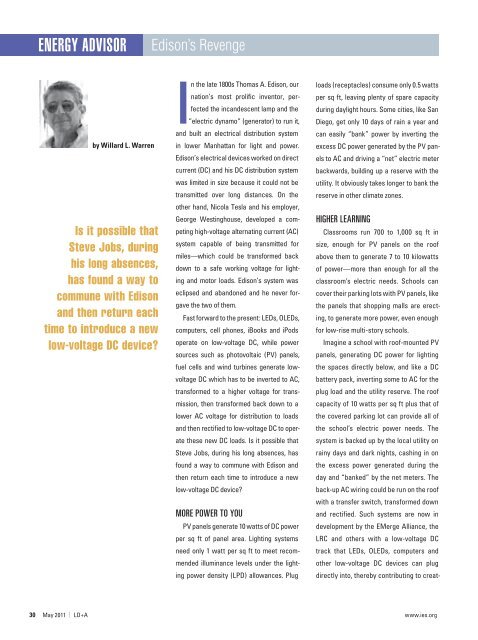May 2011 - Illuminating Engineering Society
May 2011 - Illuminating Engineering Society
May 2011 - Illuminating Engineering Society
Create successful ePaper yourself
Turn your PDF publications into a flip-book with our unique Google optimized e-Paper software.
ENERGY ADVISOR<br />
Edison’s Revenge<br />
Classrooms run 700 to 1,000 sq ft in<br />
size, enough for PV panels on the roof<br />
above them to generate 7 to 10 kilowatts<br />
of power—more than enough for all the<br />
classroom’s electric needs. Schools can<br />
cover their parking lots with PV panels, like<br />
the panels that shopping malls are erecting,<br />
to generate more power, even enough<br />
for low-rise multi-story schools.<br />
Imagine a school with roof-mounted PV<br />
panels, generating DC power for lighting<br />
the spaces directly below, and like a DC<br />
battery pack, inverting some to AC for the<br />
plug load and the utility reserve. The roof<br />
capacity of 10 watts per sq ft plus that of<br />
the covered parking lot can provide all of<br />
the school’s electric power needs. The<br />
system is backed up by the local utility on<br />
rainy days and dark nights, cashing in on<br />
the excess power generated during the<br />
day and “banked” by the net meters. The<br />
back-up AC wiring could be run on the roof<br />
with a transfer switch, transformed down<br />
and rectified. Such systems are now in<br />
development by the EMerge Alliance, the<br />
LRC and others with a low-voltage DC<br />
track that LEDs, OLEDs, computers and<br />
other low-voltage DC devices can plug<br />
directly into, thereby contributing to creatby<br />
Willard L. Warren<br />
Is it possible that<br />
Steve Jobs, during<br />
his long absences,<br />
has found a way to<br />
commune with Edison<br />
and then return each<br />
time to introduce a new<br />
low-voltage DC device?<br />
In the late 1800s Thomas A. Edison, our<br />
nation’s most prolific inventor, perfected<br />
the incandescent lamp and the<br />
“electric dynamo“ (generator) to run it,<br />
and built an electrical distribution system<br />
in lower Manhattan for light and power.<br />
Edison’s electrical devices worked on direct<br />
current (DC) and his DC distribution system<br />
was limited in size because it could not be<br />
transmitted over long distances. On the<br />
other hand, Nicola Tesla and his employer,<br />
George Westinghouse, developed a competing<br />
high-voltage alternating current (AC)<br />
system capable of being transmitted for<br />
miles—which could be transformed back<br />
down to a safe working voltage for lighting<br />
and motor loads. Edison’s system was<br />
eclipsed and abandoned and he never forgave<br />
the two of them.<br />
Fast forward to the present: LEDs, OLEDs,<br />
computers, cell phones, iBooks and iPods<br />
operate on low-voltage DC, while power<br />
sources such as photovoltaic (PV) panels,<br />
fuel cells and wind turbines generate lowvoltage<br />
DC which has to be inverted to AC,<br />
transformed to a higher voltage for transmission,<br />
then transformed back down to a<br />
lower AC voltage for distribution to loads<br />
and then rectified to low-voltage DC to operate<br />
these new DC loads. Is it possible that<br />
Steve Jobs, during his long absences, has<br />
found a way to commune with Edison and<br />
then return each time to introduce a new<br />
low-voltage DC device?<br />
MORE POWER TO YOU<br />
PV panels generate 10 watts of DC power<br />
per sq ft of panel area. Lighting systems<br />
need only 1 watt per sq ft to meet recommended<br />
illuminance levels under the lighting<br />
power density (LPD) allowances. Plug<br />
loads (receptacles) consume only 0.5 watts<br />
per sq ft, leaving plenty of spare capacity<br />
during daylight hours. Some cities, like San<br />
Diego, get only 10 days of rain a year and<br />
can easily “bank” power by inverting the<br />
excess DC power generated by the PV panels<br />
to AC and driving a “net” electric meter<br />
backwards, building up a reserve with the<br />
utility. It obviously takes longer to bank the<br />
reserve in other climate zones.<br />
HIGHER LEARNING<br />
30 <strong>May</strong> <strong>2011</strong> | LD+A www.ies.org

















